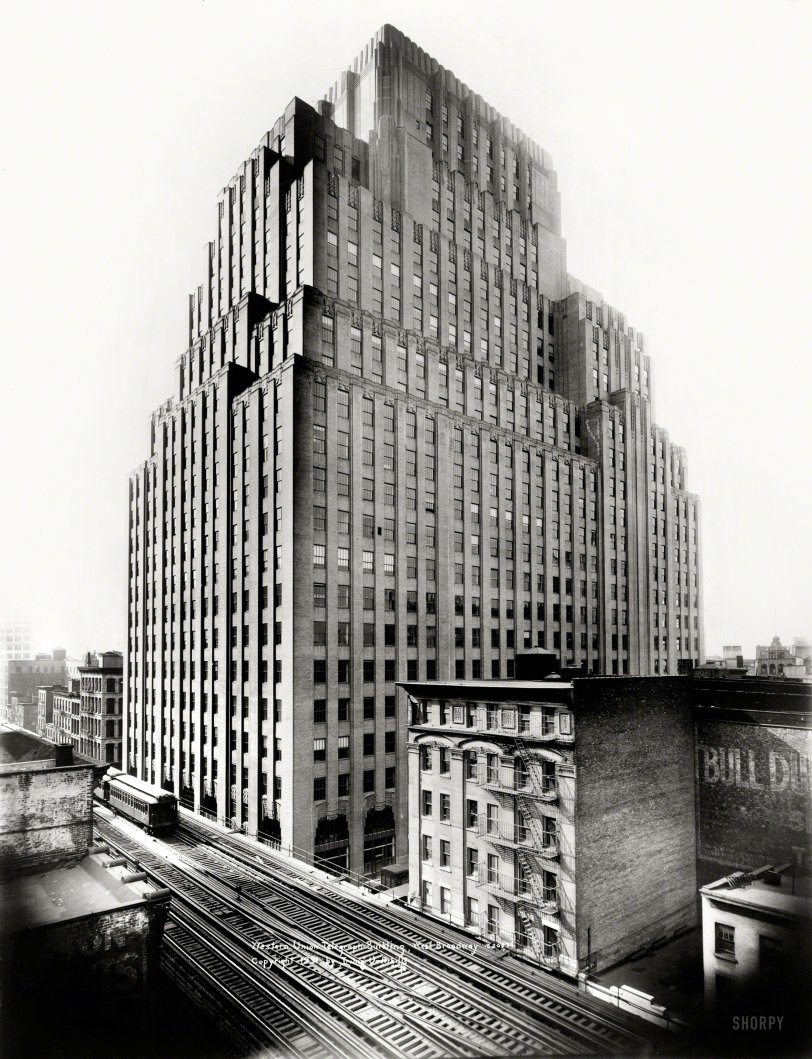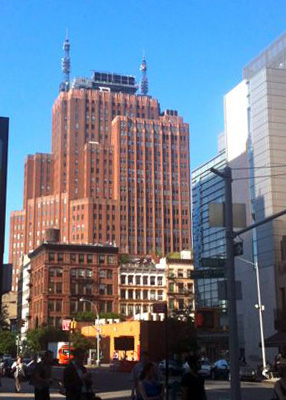


Framed or unframed, desk size to sofa size, printed by us in Arizona and Alabama since 2007. Explore now.
Shorpy is funded by you. Patreon contributors get an ad-free experience.
Learn more.

- Tough Guys
- Lost in Toyland
- And without gloves
- If I were a blindfolded time traveler
- Smoke Consumer Also Cooks
- Oh that stove!
- Possibly still there?
- What?!?
- $100 Reward
- Freeze Frame
- Texas Flyer wanted
- Just a Year Too Soon
- WWII -- Replacing men with women at the railroad crossing.
- Yes, Icing
- You kids drive me nuts!
- NOT An Easy Job
- I wonder
- Just add window boxes
- Icing Platform?
- Indiana Harbor Belt abides
- Freezing haze
- Corrections (for those who care)
- C&NW at Nelson
- Fallen Flags
- A dangerous job made worse
- Water Stop
- Passenger trains have right of way over freights?
- Coal
- Never ceases to amaze me.
- Still chuggin' (in model form)
Print Emporium
Western Union: 1931

New York, 1931. "Western Union Telegraph Building, West Broadway. Ralph Walker, architect." The hulking Art Deco pile now known as 60 Hudson Street, a TriBeCa landmark. Photo by Irving Underhill. View full size.
I Approve
The Bull City Boy likes the Bull Durham painted wall sign on the right.
Internet hotel
During the late 80s I was the account executive for the electrical contractor that did a large share of the renovation of 60 Hudson from a public utility communication building into a large Internet and private telephone (Sprint and MCI) hub. I watched with great dismay as Western Union was slowly dismantled and finally put out of business both by corporate stupidity on the part of WUTCO and by corporate raiders. Western Union was way ahead of its time in communication technology. They basically invented the fax machine, were the first to use fiber optic for communication, home-built the first digital telephone switch (it looked like something out of Star Trek ) and were the first private entity to launch communication satellites (Westar 1-6). That building holds a lot of memories for me. One last comment: in my exploration of the building I came upon the roller skate repair shop; at one time they employed young women as skaters throughout the building to deliver messages. They were truly the Google of the 1920s.
Speaking of telegrams
India has the world's last operable telegraph service. But not for much longer, as it is scheduled to be shut down next month following the sending of a ceremonial last telegram.
Companion Building
this is a cell phone picture of the at&t building on sixth ave. it is shot from the street in front of the western electric building. the fiber optics that connect the two buildings were threaded through the old pneumatic tubes that used to carry the telegraph traffic between the at&t and western union networks.

Black hole solutions?
The one on the 10th floor appears to be a vent of some sort, probably to exhaust heat from electronic equipment. It has been closed now, but the repair is clearly visible from the street with Google Earth Street View.
The one near the top of the building is a small window, maybe for a top executive's bathroom judging by its location.
Dual Addresses
60 Hudson occupies the entire block bounded by West Broadway and Hudson, Worth and Thomas streets. Other buildings in this category have street addresses on both major streets.
The AT&T Long Lines Building of the same era started with an address of 24 Walker Street and when expanded the address (for the same building) was changed to 32 AOA ( Avenue of the Americas) but the Church Street side shows an address of 316 Church Street over the entrance. Thus the West Broadway vs Hudson Street addresses.
60 Hudson is part of the Lower Manhattan communications/Internet hub. AT&T's 33 Thomas Street is two blocks away. Verizon's 140 West Street and the former AT&T Long Lines "NY-2/NR," now also a "telecom condo" at 32 AOA, are also a stone's throw away.
Metropolis of Tomorrow
Strongly evokes the work of Hugh Ferris, the man who made chiaroscuro poetry out of the New York 1916 setback law.
2 Black Holes
Anyone know what these two asymmetrical openings are for?:
1. About halfway up the facing side of the building, between the 3rd and 4th windows, is a small black rectangular opening.
2. To the left of the 2nd row of windows from the top is another rectangular opening, with a small window in it.
Neither of these has a balancing twin in sight.
Sixth Avenue El
The elevated train in the foreground is the Sixth Avenue El, built around 1880, which ran over West Broadway in this part of lower Manhattan. Service ended in late 1938 and the structure was demolished soon after. While New York had an unfortunate habit of closing elevated lines when no replacement subways were available (Second Avenue El 1940, Third Avenue El 1955, Jamaica Avenue El 1977), that actually wasn't the case with the Sixth Avenue El, as the IND subway under Sixth Avenue made it largely redundant. In addition, while the other els were perfectly serviceable despite their ages, the Sixth Avenue El was in rough physical condition and would not have been usable for much longer without massive renovations.
For years after their demolition, rumors persisted that scrap metal from the Sixth and Second Avenue els had been sold to companies in Japan, which incorporated the steel in weapons used against the United States in World War II. It got to the point that the city actually had to hold an official inquiry into the issue. The rumors turned out to be about as true as the rumors that full-grown alligators live in the city's sewer tunnels.
Technology changing with the times.
Ralph Walker designed two buildings for old-economy telecommunications that are still being used for new economy telecommunications over 80 years later. The Western Union telegraph building here is now a major internet hub for NYC and the entire world.
His other masterpiece, the Barclay-Vesey building, was designed for AT&T long distance traffic in 1926 and is now the world headquarters for Verizon Wireless.
























On Shorpy:
Today’s Top 5